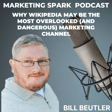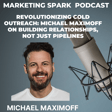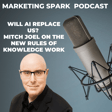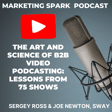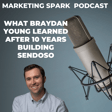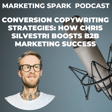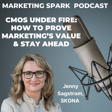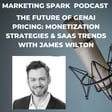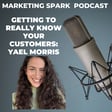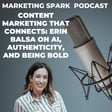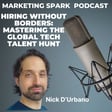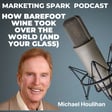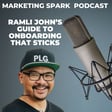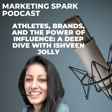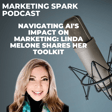Become a Creator today!Start creating today - Share your story with the world!
Start for free
00:00:00
00:00:01

Exploring the World of Direct Mail Marketing
While marketers are obsessed with all things digital, direct mail marketing is alive and well.
There's huge value in being able to target people by their physical addresses. As important, brands that leverage direct mail marketing are seeing impressive ROI.
In this episode of Marketing Spark, Postie CEO Dave Fink talks about why direct mail is viable option for many brands and how it liberates marketers from dealing with tech giants like Facebook and Google.
Dave also talk about his experiences as one of the first investors in Dollar Shave Club and what it was like to work with founder Michael Dubin.
Transcript
Introduction to Marketing Spark Podcast
00:00:07
Speaker
Hi, it's Mark Evans, and you're listening to Marketing Spark, which features conversations with entrepreneurs and marketers about business, sales, and of course, marketing.
Understanding Direct Mail in Business
00:00:17
Speaker
Many brands are heavily invested in direct mail to attract and engage prospects and customers. Direct mail can be personalized, tracked, drive online and offline sales, and support the entire customer journey.
00:00:31
Speaker
day think the CEO and founder of Posty lives and breathes in this world as a direct mail expert.
Meet Posty's CEO and Direct Mail Expert
00:00:38
Speaker
In today's episode of Marketing Spark, we're going to take a deep dive into direct mail marketing and how it plays with social media and other platforms. Welcome to Marketing Spark. Thanks for having me.
The Success Story of Dollar Shave Club
00:00:49
Speaker
I've listened to a bunch of other podcast interviews that you've given and obviously the sexy part of your story is your involvement with Dollar Shave Club. Everyone knows how successful that was and how marketing played such an amazing role in driving the brand and ultimately billion dollar acquisition by Unilef. Walk me through your journey with Dollar Shave Club, which I guess started with an incubator or an accelerator called Science Inc.
00:01:17
Speaker
That's correct. Look, it is a fascinating story and I've never seen anything quite like it before. That entire story really unfolded in four years, which I guess in internet time is maybe eight years or 10 years. But when you think of an entrepreneur starting with an idea, a category, a product or service, they want to disrupt or improve and bring that to market.
00:01:41
Speaker
drive awareness, become really a household name globally, scare the pants off a $50 billion incumbent and then get acquired for 10 figure plus outcome that doesn't happen very often. Yeah, I got to see it from the start.
00:01:57
Speaker
So I was a partner at a tech studio in Santa Monica called Science, and we had a focus on marketing technology investments and business creation, as well as direct-to-consumer brands. So now, I think we're all buying from brands that were created online in a direct-to-consumer way, but it's still pretty early back in, I think this is 2011,
00:02:23
Speaker
And Mike Dubin, who is a first-time entrepreneur, but a very experienced, I think, creative mind, had this idea to go right at the men's grooming sector, starting with razors, which I think everybody considered that business suicide. No one really had been able to put a dent into Gillette.
00:02:41
Speaker
for many, many years. And that was because they owned retail distribution, wholesale distribution, and the world changed. And so literally Mike showed up and was looking to raise capital and figuring out ways to get this concept off the ground.
00:02:58
Speaker
And we were fortunate enough to convince him to do it with us at Science. And we were first money into his adventure. We saw the launch of the website. We saw the creation and explosion of awareness through his amazing viral video and follow-up videos. And we saw him grow a business that acquired, I think, between three and four million subscribers within just a few short years.
00:03:26
Speaker
It was incredible. Let's take a step back.
Analyzing Subscription Commerce Strategy
00:03:29
Speaker
Mike Dubin, very personable, charismatic, creative person walks into your office with this idea of taking on Gillette and all the big razor makers. What was your first impression? Were you impressed by the way he carried himself? Were you impressed by his vision or his audacity? Why did you decide to strike a partnership
00:03:54
Speaker
with Dubin, when he made the viral video and sort of emerged at this very dynamic entrepreneur, it was easy to see why, yeah, that makes sense. What spurred on your involvement with Mike and the Dollar Shave Club? Yeah, so at that point, subscription commerce, which I think is a pretty common method for engaging with consumers these days, was kind of just becoming a common business model. And it was a thesis that we were spending a lot of time researching, playing, thinking about, right?
00:04:23
Speaker
of how do you both introduce consumers to, or prospect consumers to your product offering, and then how do you think about investing advertising dollars to acquire consumers at scale? And one of the methods is, as probably many of your listeners think about it, is this idea of understanding what your customer acquisition cost is, and then understanding what your expected lifetime value and lifetime margin is of that customer to know just how aggressively you can
00:04:53
Speaker
spend into your growth. One of the things that was was interesting about subscription commerce is there's
Opportunistic vs. Mission-Driven Businesses
00:04:59
Speaker
in theory, there's a built in lifetime value because you're not just acquiring a one time transaction like you may do it at a Walgreens or a CVS or
00:05:09
Speaker
longs or whatnot. You require a customer that's buying into this idea of being a part of a club or accepting the convenience along with the quality product or fair pricing that you can get direct to consumer. To us, what was interesting is that this fell smack within that category of an obvious need or consumer willingness to engage and commit to this idea of a subscription. It's a consumable product
00:05:33
Speaker
You go through razor cartridges. There was kind of a built-in mechanic. Whereas there are other businesses that we've all seen where they've tried to force this subscription model into business that doesn't necessarily make sense. I don't need a new pair of shoes every three months. I might like a new pair of shoes every three months, but I don't know when my soles are going to wear out or whatnot. But with razors, you generally know that each month you need more blades.
00:05:57
Speaker
That was appeal one, just kind of that business model. Appeal two was, I mean, look, Mike, as you said, he's just a dynamic, larger-than-life personality, had a tremendous amount of passion. He had incredible motivation. And he had this vision of telling, of kind of cracking this kind of formula of
Resurgence and Effectiveness of Direct Mail
00:06:17
Speaker
digital storytelling.
00:06:18
Speaker
in an era where social media was just becoming social media. We all take for granted what YouTube is and what Facebook is now, but this was 11 years ago. Those platforms still existed, but marketers had not yet figured out how to crack the formula of how to engage consumers and delight consumers through those platforms at that time. And Mike had a bit of a twinkle in his eye and the nature of his background had him well positioned to be a storyteller, first as a marketer and then maybe a customer acquisition engine.
00:06:48
Speaker
So you put those together and it seemed like an interesting project to engage with. I am not going to claim that any of us had any idea that he was going to launch this video. It was going to go viral overnight and he was going to be sold out and scrambling to figure out how to build his infrastructure literally overnight. That no one could have predicted or certainly we didn't.
00:07:12
Speaker
Yeah, when people look at the success of Dollar Shave Club, they focus, laser focus on that viral video which he made for a few thousand bucks and opened the floodgate for sales and arguably a global brand. When you as a marketer look at Dollar Shave Club's success, aside from the viral video,
00:07:35
Speaker
What do you see as some of the things that Dollar Shave Club was really effectively allowed to embrace? What did it do well? Where did it stand out? And how were those marketing decisions made?
00:07:48
Speaker
They did a lot of things really well. I mean, you obviously don't have that level of success if you didn't do a lot of things well. And I think you have mics traveled around the world speaking to business school classes and MBA programs, trying to deconstruct some of that success. When I look at it.
00:08:07
Speaker
First and foremost, and I've talked about this in some of the other podcast conversations I've had, and I really, truly believe it. There are two types of businesses that I've seen created and had the benefit of getting a front row seat to seeing dozens and dozens of businesses launch, just being in this market, in this world, and then being at a company that was built around investing and launching startups.
00:08:32
Speaker
The kind of big divide that I've seen is that there are those businesses that start out opportunistically and those businesses that start out mission-driven. And what I mean by that is there's no shortage of companies where the founders come from the industry that they're playing in with their next business, they have deep expertise, they understand
00:08:50
Speaker
supply chain or something about improving a product or service. And they have a business model that they know that they could monetize. And those are fine. There are lots of businesses that have been wildly successful built kind of opportunistically. To me, what's more interesting is these mission-driven businesses.
00:09:08
Speaker
And I don't mean you're out trying to solve the most challenging problems in the world. What I mean is like you've uncovered a problem or a solution or a pain point that is real or even that there's a perception of in the consumer side or business psyche and your mission driven around trying to solve that pain point. It can be really nuanced and focused. It can be broad. Well, if you look at Dollar Shave Club, I mean, from the start as that amazing script and viral video talked about,
00:09:34
Speaker
There was a bit of a pain point in men's grooming and razors in particular. Razors were tracked as the number one stolen item in retail. There's a reason you feel like a criminal when you walk into a retail outlet and an alarm goes off when you lift the plastic bin or you have to get someone to unlock the case to see that you could buy this product.
00:09:56
Speaker
And then you ask yourself like, well, why is that? For the same reason that viral video talked about, there was, you know, one brand or, you know, one conglomerate that owned 80% of the market could charge what they wanted to charge for a product. Probably were greatly overcharging for this commodity. And we've all had the experience of, you know, going through Target checkout and maybe we have like five items and you're like, it's $117. And you're like, what in the world did I buy? And you bought razor blades.
00:10:23
Speaker
That's crazy. Nobody wants to spend that kind of money on razor blades. Nobody really wants to even be shaving, probably. It's something we do because we don't have a choice, so the hair interface will keep growing if we don't. That was Mike. I think through his really creative approach to storytelling and...
00:10:39
Speaker
being able to leverage social media at a time that it was less competitive than it is now. And if you get things right, you could really get a lot of our media. He was able to unlock that kind of pent up frustration about, yeah, yeah, Gillette is overcharging me for these razors. Like, this is crazy.
00:10:54
Speaker
You're like, why don't I have more consumer choice? This is nuts. And even the name of the company, Dollar Shave Club, most of the products were not a dollar. But just everything about that was this irreverent approach to being mission-driven around the idea that, look, you can get an equally good shave for a lot less money and not feel like you're being taken advantage by a conglomerate just because they can.
00:11:17
Speaker
That was really the beginning of all these direct-to-consumer brands that were waking up and saying, hey, don't buy this product just because it's what your parents bought 30 years ago, and don't use this toothpaste just because that's what you were told, that's what you were grown up on. Open up your eyes, ask your own questions, make your own decisions, and then be a part of those brands that you think represent you.
Scalability and Data-Driven Direct Mail
00:11:38
Speaker
And I just think that more than anything, that Dollar Shave Club got that right.
00:11:43
Speaker
When I work with B2B SaaS companies, one of the challenges they face is that the marketing buffet is extensive. There's so many things that you can do.
00:11:54
Speaker
Inevitably, you find startups that rally around one or two channels. For Dollar Shave Club, obviously it was video. For a lot of companies, it could be social media or content marketing. How did you come around to, or what was the reason why you decided to focus on direct marketing? Which is not as sexy as a video or social media, but it's been around for a long time and it's super effective. Two questions, one is why your interest in direct marketing
00:12:23
Speaker
And how is Posty's approach to direct marketing different from all the other companies out there?
00:12:30
Speaker
Well, I have to admit, I love both those questions. Of course. So first and foremost, my co-founder Jonathan and I didn't come around to the mission of solving the direct mail space or problem or challenges in this channel. That wasn't where it started. It really started as a reaction to the big walled gardens that are search and social, which is gaining way too much power.
00:12:57
Speaker
and creating a lot of great value but also creating a lot of heartburn up and down brand and executive teams and marketing teams. The Dollar Shave Club era, those were the golden ages of platforms like Facebook and Google and YouTube providing tools that
00:13:16
Speaker
we'd never seen before. Partly is just the pure scale, right? At one point, like everybody was on Facebook and it was ubiquitous with the internet. And it was really nice and convenient to be able to reach everyone on one website, essentially. The sophistication in tools and use of data and the emergence of machine learning and predictive modeling, all these things that we used to do, but in a more analog way with less sophistication, those channels really were able to invest in.
00:13:43
Speaker
and it made us all look like really smart marketers and for a long time we got tremendous amounts of gains but we all have felt the pain point of you know google changing algorithm and the bottom falling out of our search marketing or facebook deciding that after
00:13:58
Speaker
milking tons of profits from us buying fans to our Facebook. Fan pages and building the engagement on their platform, they're not going to turn around charges to reach those fans where you paid to acquire. And that has dramatic effects on our growth and our P&L.
00:14:15
Speaker
For us, the kind of final straw was like just the oversaturation. Every brand in the beginning, it was like the disruptor brands that were finding out how to work on how to manage demand on Facebook. And then Facebook did a great job pulling over lots of huge portions of brand advertising dollars and automotive manufacturers.
00:14:33
Speaker
entertainment platforms and CPG brands, et cetera, we're pumping lots of their marketing budgets into those platforms and ad rates go up. And it seems like the savvier we get at marketing those platforms, we just can't, we can never catch up with the inflation on ad rates. And so you never are able to run those channels profitably.
00:14:53
Speaker
So for us, it was just a matter of, okay, well, what's the next channel? Like we need to diversify our media mix exactly what you were just talking about. And we first started looking at other digital channels and emerging channels. And there was nothing that had enough scale to make it worth the effort.
00:15:09
Speaker
Snap was just getting started. They didn't have an ad platform at that point. There was no TikTok. There was nothing that rivaled the scale of Facebook, of YouTube, Google. We started spending more time offline. And in offline, there are a lot of great channels, but DM caught our attention again because a lot of the components of it are very, very similar to digital channels. It's a channel that allows for
00:15:34
Speaker
for targeting an applicable data use so that you can be razor focused on who you engage with. There's direct measurement. You're able to understand who you're engaging with and you're able to triangulate that conversion data. So what's working and what's not working from your marketing experience. And it's big and scalable. It's bigger than Facebook, it's bigger than Google. Everybody has an address and anyone with an address is reachable through direct mail.
00:15:58
Speaker
So you put those three things together, big and scalable, lots of data, which makes it a test and optimizable channel and direct measurement. And the reality is it looks very similar to how we execute Facebook campaigns and Google campaigns. So that's how we got there. It wasn't a direct path to direct mail. It was a reaction to a big macro challenge we saw in the marketing landscape.
00:16:24
Speaker
Scott Galloway talks a lot about the digital duopoly between Facebook and Google. And if you're a brand and you want to leverage advertising, you have no choice. You have to use one or the other.
00:16:37
Speaker
And at the same time, I think a lot of marketers are scrambling because every single channel is chock-a-block with competitive options and everybody's trying to leverage them. Direct mail seems old school. It really seems like, in some respects, an anachronism, but it's not. I mean, it's alive and it's well and brands are still using it. Do you think the modern marketer is thinking about direct mail these days?
00:16:58
Speaker
Is it front and center to them, or do they have to be educated on the benefits, the impact, and the fact that there are lots of ways to measure it? Because the modern marketer, it's all about quantifying their performance. If they can show that they're doing the job, that's awesome. But with the rise of the dark web, which I want to talk to you about, those things are becoming less obtainable. I think the same mindset of marketers that
00:17:27
Speaker
first looked at Facebook and thought, hmm, there's something interesting here. Even before Facebook was building ad tools or marketing tools on their own platform, they were trying to figure out creative ways to engage the Facebook audience. Those same marketers are absolutely engaged with direct mail and have been for a while and are recognizing the value and we're trying to figure out ways to
00:17:50
Speaker
kind of infiltrate that channel in a very kind of test and optimization and measurable way.
Posty's Predictive Tools and Targeting
00:17:56
Speaker
We've seen it from the start and we've been at it about six years now. With that being said, there's also a sea of really savvy brands that have relied on direct mail, even through the digital era. This year, the last numbers that I saw published said there's going to be about $50 billion spent in direct mail by advertisers just in the US alone.
00:18:19
Speaker
And it's a non-national election year. That just tells you something. Ad dollars are up in the channel. And that's not happening by accident. That's partly because I think we recognize the value of everything has grown, right? The venture dollars that are flowing in bigger than ever, consumer spending's never been stronger, expendable income's never been stronger. And so there's opportunities to market into your target audience more aggressive than ever before.
00:18:48
Speaker
But at the same time, the platforms that you've relied on, namely Facebook and Google, have become harder and harder to actually find profitable customers on, or at least beyond a certain ceiling of scale. Definitively, the savvy marketers that are cutting edge and forward thinking, ironically, are well aware of and very focused on direct mail.
00:19:12
Speaker
I think type of advertisers are the ones that are on our platform or have been for years. And we're very grateful to have a company like Posty that was building technology to give them the same access to predictive modeling and measurement and targeting and programmatic capabilities than kind of traditional methods of deploying DirectML.
00:19:34
Speaker
And every day we have more and more inbound markers and brands that either are looking for a better way to do direct mail that have already kind of experimented with the channel and seen some positive benefit, but are satisfied with the tools. And then we have new advertisers that are aware that their competitors are deep in the channel and they don't have the experience and are looking for kind of the fastest path to scale and success within the channel.
Measuring Success in Direct Mail
00:19:59
Speaker
Without getting too deep into the weeds, can you talk about how
00:20:04
Speaker
marketers, how brands can quantify their success with direct mail, because the model is that you do some targeting by geography, postal code, zip code, however you want to do that, then there's some kind of reaction happens. What are the metrics? What are the KPIs involved in direct mail?
00:20:21
Speaker
Yeah. So the beauty of direct mail is it's an addressable channel. Meaning that it's not about contextual targeting or not about, doesn't have to be about zip code targeting or census block targeting or whatnot that some more traditional marketers might remember on the channel for. It's an individual living in a household the same way that it's one-to-one on programmatic or email or SMS or search or Facebook.
00:20:47
Speaker
In a world where there's so much access to first party data within brands and an ability to really get to know and understand your consumer directly. You're not relying on understanding the basic demographics of a zip code around a retail location that your product is sold in. You're now selling directly to that consumer or some portion of your revenues generated from direct consumer sales. And you can unlock a lot of insights into that.
00:21:12
Speaker
Those insights can be used to target on digital channels and can also be used to target on through direct mail. Direct mail, you're targeting individuals at specific addresses. And when you're selling direct to consumer or you have a POS system that is capturing a one-to-one identity map between a trans actor and who that person is, a converter in that
00:21:34
Speaker
The Posty platform, it's not the only one, but Posty makes it clean and real time and simple to map that identity from a transaction back to the recipient of a piece of direct mail. There's much deeper methods that we can certainly go into. Fear boring, talking too deeply about measurement.
00:21:52
Speaker
But any action where identity data can be captured, whether it's a mobile application action or a website action or POS action at a retail outlet that captures that data, that can all be used in real time very cleanly to map back to audiences that received an ad through the mail.
00:22:11
Speaker
And part of the game with measurement is then, you know, understanding not just what was successful in the past, but being able to make good decisions and that will deliver reliable, similar results the next time you execute that same strategy or tactic. We all think about like, and you actually mentioned it as well, like measurement as.
00:22:29
Speaker
as being this way to kind of justify that what we did is right. When I think about growing a business as a CEO, I think about, you know, measurement more as the competence in believing that if I do more of what I just did, I'll get similar results. And, and Dreck Melza is, enables that. You could argue that many marketers have this myopic view of digital marketing. The marketing landscape is digital, and many of them have been raised in an all digital
00:22:57
Speaker
all web environment. So they don't know anything different. Magazine advertisements to them, newspaper ads seem like anachronisms more than anything else. How does a marketer blend digital marketing with direct mail? How do they create a value proposition in which one plus one equals three? Is it easy to do? Is it easy to get those two different vehicles to seamlessly work together?
00:23:25
Speaker
Look, nothing is easy. If it was easy, we'd all be launching brands and reaching certain levels of success. It's really hard to do. But I think your question is probably more when you take the savvy trained marketer who's used to a sophisticated set of tools, it does direct mail or army channel become more difficult. And I think the answer is depends which channels that you're using and the clarity of measurement in them.
00:23:51
Speaker
There are just channels that are easier to measure and there are channels where there's more transparency. Facebook and Google have positives and negatives. They make it really easy to have complete transparency on their own platforms with their own reporting structures. So you understand exactly what Google thinks your KPIs are and what Facebook thinks their KPIs are. They make it much harder to understand things like incrementality, your lift of using those ad platforms on top of other channels.
00:24:21
Speaker
And that's something that's been going on for years and years and years, right? There's the argument of first-touch, first-last-touch, first-media-mixed-modeling, and multi-attribution, and whatnot. DirectMella is a unique channel in that you have a lot of variance in the KPIs that you're using at different times to measure effectiveness of your campaigns, the return ad spend, et cetera.
00:24:44
Speaker
For example, there are times when you're in growth mode and your due north is the most amount of scale, it's a land grab and the most efficient cost per acquisition. And if that's your due north, direct mail as a channel can play really nicely with your digital channels and help you understand exactly what your cost per acquisition from budget spent in direct mail is.
00:25:07
Speaker
You may be a more mature brand that's looking and saying we have a media mix and we're more about profitability right now. It's not so much a land grab, any new incremental channel. We also want to be able to see what the incremental effect over other channels are.
00:25:22
Speaker
direct mail because it's not a walled garden. It's not Facebook owning the data and dictating what data they're going to give you and what data they're not going to give you. Oftentimes pump up and make performance of ad dollars on their platforms look better. You're direct mail, you have control over. So if all of a sudden what you're looking for is how does
00:25:42
Speaker
this specific addressable audience within my target CRM or my prospect pool perform when direct mail is added. What does the incrementality look like? What does the lift look like? Well, direct mail measurement has the capability to show you exactly what the incremental value of that media spend looks like.
00:26:01
Speaker
and really anything in between. To me, that's one of the things that's beautiful. It can be dangerous as well because direct mail offers more views and many times a cleaner view of a performance that even Facebook or Google will. And so a marketer needs to come to the channel understanding that they need to look at different measurable tactics or strategies differently. Just use Facebook says, this is your
00:26:25
Speaker
LastClick CPA doesn't mean that there's any incrementality in the value of those ad dollars that you come to that channel. And if you're comparing LastClick Facebook CPA to incremental lift on direct mail, that probably is a dangerous comparison. But if you're looking at that like measurement, then you come to trust the direct mail channel a bit more than you can trust your digital channels.
Direct Mail vs. Digital Advertising
00:26:50
Speaker
Earlier in the conversation, I mentioned the dark web and a lot of marketers are
00:26:54
Speaker
grappling with the idea that not everything can be quantified, given that in their experience in recent years, everything is quantifiable. And I think a lot of marketers are trying to figure out how do they generate ROI? How do they show their boss that what they're doing is working? How do they
00:27:15
Speaker
prove that they're doing what they're supposed to do. And I am curious about how direct mail fits into this whole dark web, dark social, not terribly able to quantify what we're doing landscape.
00:27:31
Speaker
Well, the beauty of direct mail and those marketers who are engaging in exploring the channel right now, which if any of your listeners are not yet engaging the channel, I highly recommend them starting to as it becomes more and more difficult to measure performance online through changes in operating systems and privacy regulations, et cetera. The beauty of direct mail is that the match key is not a cookie.
00:27:58
Speaker
It's not an abstract digital fingerprint. It's a name and an address. And when you engage with a consumer that's willing to share name and address, they know exactly what data they're sharing with you. And they're doing so in a very compliant, upfront, transparent way, which is respectful to the consumer. And the brand is presenting respectful. But it also means that if iOS 14 blows the cookie away, it affects your ability to measure just as cleanly and direct amount. Because
00:28:27
Speaker
address still exists. The US government didn't take away our addresses, right? That's not a thing, right? The way that Apple can take away a cookie or deem it irrelevant. We think a lot about that, think per se that digital advertising is going to die in any respect, but some of the ease and transparency of what works online and what doesn't work online is not going to be so clean and
00:28:51
Speaker
there are going to be challenges. It's going to create some fits for marketers and brands. By the same token, I think what we're all going to see, I've done my own analysis and research through many times throughout the years, is that the ROI, the term that I'd spend, that some of these big walled gardens were telling us we were getting, we weren't actually getting.
00:29:12
Speaker
So we start pulling back budgets and all, and we don't see the same, you know, proportionate decline in total conversions or total customers or, or revenue. And, and I think that's just, the by-products is going to be, it's going to shed some light onto maybe some of the inaccuracy and, and, and overreliance on some of the performance KPIs that these walled gardens were giving us access to. It's something that again, for the life of our company, Duroc Melages doesn't have that same
Conclusion and Further Resources
00:29:41
Speaker
Paying point, there's a lot more transparency in how measurement works because it is one-to-one tied to an actual consumer rather than this ephemeral digital representation of a consumer.
00:29:53
Speaker
Well, thanks for all the great insight about Direct Mail, something that I haven't explored in recent episodes of the podcast. One final question, where can people learn more about you and Posty? Our website is filled with information, use cases, case studies, how to get started, et cetera. And there's a request for information or functionality as well. And our team will get in touch with you. Certainly, I'm always reaching both through LinkedIn. That kind of is my go-to. So feel free to find me there. And I think that'll be a good way to get everybody started.
00:30:23
Speaker
Well, thanks for listening to another episode of Marketing Spark. If you enjoyed the conversation, leave a review, subscribe via Apple Podcast or your favorite podcast app, and share via social media. To learn more about how I help B2B SaaS companies as a fractional CMO, strategic advisor and coach, send an email to mark at markevans.ca or connect with me on LinkedIn. I'll talk to you later.

